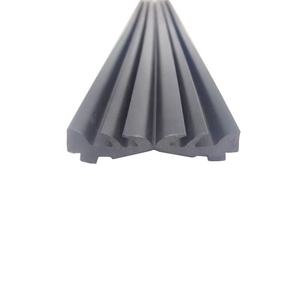Dilatation seals, often referred to as expansion joints or expansion seals, are essential components used in various engineering and construction applications to accommodate thermal expansion, contraction, vibration, and other forms of movement in a wide range of structures and systems. These seals are designed to maintain the structural integrity of a system while allowing for the necessary flexibility to withstand dynamic environmental conditions and mechanical stresses.
Here is a detailed description of dilatation seals:
- Purpose: The primary purpose of dilatation seals is to prevent damage to structures and equipment caused by temperature fluctuations, ground settlement, seismic activity, and mechanical movements. They effectively bridge the gap between two adjacent structural elements or components, ensuring they can move relative to each other without causing stress or damage.
- Types:
- Single-Arch Expansion Joints: These are designed to accommodate movement in a single direction and are commonly used in piping systems.
- Double-Arch Expansion Joints: These provide flexibility in two directions, making them suitable for more complex systems.
- Universal Expansion Joints: These are designed to compensate for movement in multiple directions and are often used in complex industrial applications.
- Materials: Dilatation seals are made from a variety of materials, including rubber, neoprene, EPDM, stainless steel, and other alloys. The choice of material depends on the specific application, temperature range, and the type of media the seal will come into contact with.
- Design: Expansion joints come in various designs to suit different applications. Some common types include:
- Bellows Expansion Joints: These consist of a series of convoluted metal bellows or elastomeric bellows, which provide the necessary flexibility to accommodate movement.
- Slip-Type Expansion Joints: These use sliding plates to compensate for movement and are often used in bridge expansion joints.
- Gimbal Expansion Joints: These allow for angular rotation in two planes and are often used in piping systems.
- Hinged Expansion Joints: These provide angular rotation in a single plane and are used in situations where movement occurs in only one direction.
- Applications:
- Piping Systems: In industrial settings, dilatation seals are commonly used to connect sections of pipelines or ducts where thermal expansion and contraction are significant concerns.
- Bridges: Expansion joints in bridges allow the structure to expand and contract with temperature changes and settle with the shifting of the ground.
- Buildings: In construction, expansion joints are used to separate different sections of a building, allowing for movement without causing cracks or structural damage.
- Power Plants: They are used in power generation facilities to absorb movement and vibration in piping and ducting systems.
- Maintenance: Regular inspection and maintenance of dilatation seals are essential to ensure their continued effectiveness. This may involve checking for wear and tear, inspecting for leaks, and replacing damaged components.
- Safety: Properly functioning dilatation seals contribute to the safety and longevity of structures and systems by preventing the build-up of stress, which can lead to catastrophic failure.
In summary, dilatation seals are crucial engineering components designed to manage the movement and stress that can arise in various structures and systems due to environmental and mechanical factors. Their use is widespread in industries such as construction, manufacturing, and infrastructure development, ensuring the integrity and safety of a wide range of applications.






